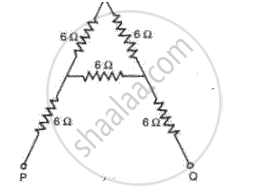Advertisements
Advertisements
प्रश्न
Three 2 V cells are connected in series and used as a battery in a circuit.
How many joules of electrical energy does 1 C gain on passing through (i) one cell (ii) all three cells?
उत्तर
(i) For one cell:
V = 2 V
Q = 1 C
And also:
Electrical energy gained = Work done
So using the relation, V = W/Q or W = V x Q
= 2 x 1 = 2 J
(ii) For three cells:
V = 6 V
Q = 1 C
So, W = V x Q = 6 x 1 = 6 J
So 2 joules and 6 joules of electrical energy is gained for the above two cases (i) one cell and (ii) all three cells, respectively.
APPEARS IN
संबंधित प्रश्न
Fill in the folloing blank with suitable words:
A current is a flow of ............... .For this to happen there must be a ............... circuit.
The following table shows the current in Amperes and potential differences in Volts.
- Find the average resistance.
- What will be the nature of the graph between the current and potential difference? (Do not draw a graph.)
- Which law will the graph prove? Explain the law.
| V (volts) | I (amp) |
| 4 | 9 |
| 5 | 11.25 |
| 6 | 13.5 |
Find the effective resistance in the following circuit diagrams (Fig.):

In a house there are 6 bulbs of 100 W each used for 4 hours a day, 4 bulbs of 60 W each used for 8 hours a day, an immersion heater of 2.5 kW used for 1 hour per day, and an electric iron of 800 W used for 2 hours per day. Calculate the cost of monthly electric bill for the month of April at the rate of 80 p per unit.
Explain with the help of a diagram how does 'short circuiting' occur in an electric kettle.
Tick (✓) the correct choice among the following :
(a) A strong short bar magnet is dropped into a solenoid connected to a
galvanometer as shown in fig . The galvanometer shows a deflection to the left when the current in the coil as seen from above is counter clockwise. Which one of the following shows the correct deflection of the galvanometer when the magnet is at posi tions A, Band C.
1 kWh = `(1 "volt" xx 1 "ampere" xx "_________")/1000`
Answer the following question.
An electric lamp of resistance 20 Ω and a conductor of resistance 4 0 are connected to a 6 V battery as shown in the circuit. Calculate: 
(a) the total resistance of the circuit,
(b) the current through the circuit,
(c) the potential difference across the (i) electric lamp and (ii) conductor, and
(d) power of the lamp.
State the condition when it is advantageous to connect cells in series.
What is the rate at which charges flow past a point on a circuit?
